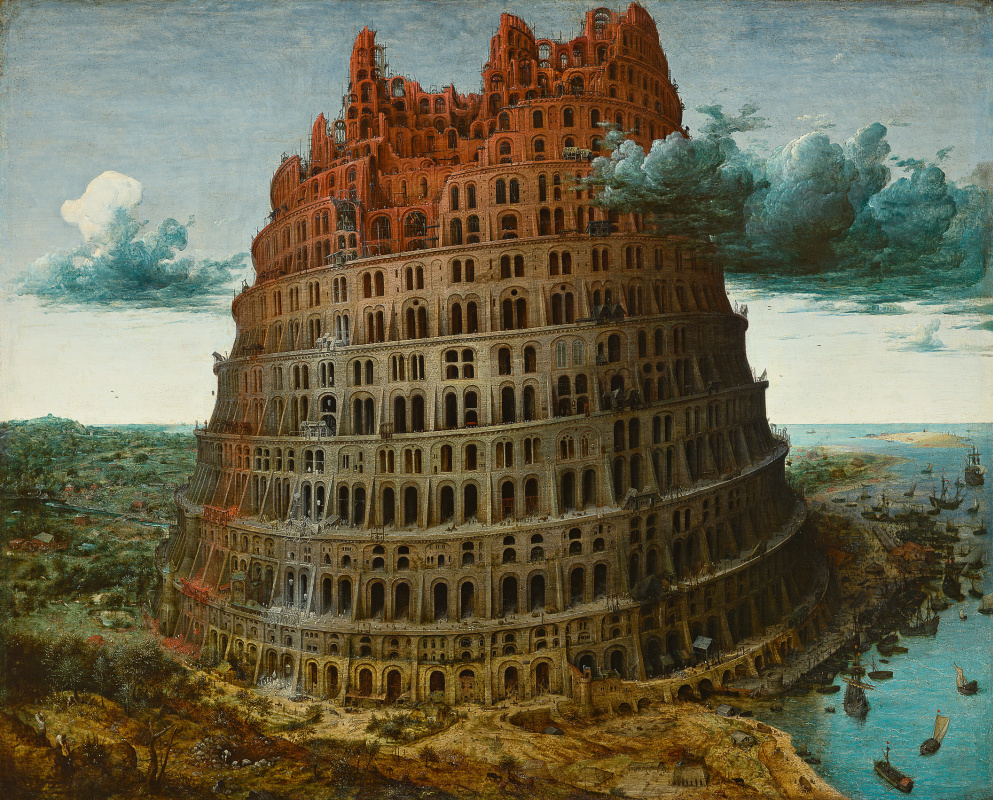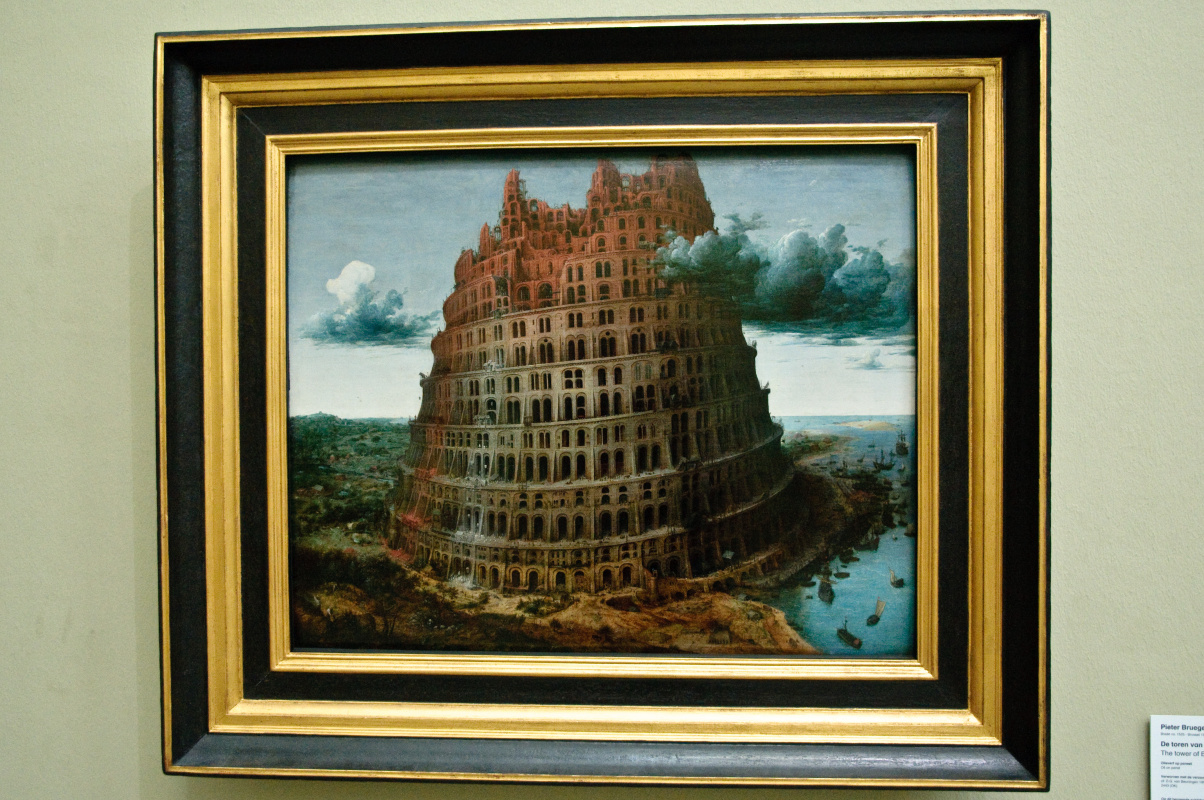log in
Enter site
Login to use Arthive functionality to the maximum
The Tower of Babel (little)
Pieter Bruegel The Elder • Peinture, 1565, 59.9×74.6 cm
Descriptif de la toile «The Tower of Babel (little)»
Painting By Pieter Bruegel The Elder "Tower of Babel", an ambitious work by the artist, written in 1565.
The artist has created a number of works on this subject. Based on the work of Bruegel the Elder called "the tower of Babel" is an allegory on the hubris of man. Interestingly, in the work that was created on the same subject before ("Little tower of Babel"), the structure is completely suppressed human beginning. The second picture of the master, with all its grandeur and poetic, filled with a sense of life that comes through in the numerous figures of the builders, and the moving carriages, and in the landscape (especially in the sea of roofs close to a tower). Here the painter does not simply walk away from the suppression effect, and should further — he's trying to look at the nature of humanity.
Based on the painting by Pieter Bruegel the Elder's "tower of Babel" is an episode of one of the books of Moses about the construction of the tower, what people planned to reach heaven. In order to humble human pride, the Lord confounds the languages, which becomes impossible to understand each other. It divides people, so the construction never ended. The conclusion of this work is the perishability of everything, the vanity of human desire to align with God.
"Tower of Babel" by Pieter Bruegel the Elder is consistent with the traditional view of the parable in the painting: see the impressive scale of the works depicted a variety of characters, a variety of vehicles. There is evidence that in 1553, the painter visited Rome. In the "tower of Babel" you can easily see the Colosseum from the specific to elements. The building is surrounded by barracks, cranes, hoists, which were used then; ladders, scaffolding; 7 floors buildings built, hard at work on the next. At the base of the tower is the port city. A place to build a tower, characteristic of the marine landscape like the Netherlands.
The characters shown on the canvas (laborers, masons) seem extraordinarily young, his zeal, they are like ants. Much more noticeable is the figure of Nimrod, the famous conqueror (II Millennium BC), which had inspected the object, it is traditionally considered a leader in the construction of the tower is also clearly visible in his entourage at the bottom of the canvas. Deep, Eastern-type bow of the employees of the head — a tribute to the origin of the plot. As I thought of the author, the failure that befell such a big project, caused no language barrier, and the errors that were made during construction. A huge tower can be quite substantial, but on closer observation it is noticeable that the tiers are askew, the floors below are not completed or are destroyed, the building itself is tilted in the direction of the city, and the future of the whole project is quite sad.
The artist has created a number of works on this subject. Based on the work of Bruegel the Elder called "the tower of Babel" is an allegory on the hubris of man. Interestingly, in the work that was created on the same subject before ("Little tower of Babel"), the structure is completely suppressed human beginning. The second picture of the master, with all its grandeur and poetic, filled with a sense of life that comes through in the numerous figures of the builders, and the moving carriages, and in the landscape (especially in the sea of roofs close to a tower). Here the painter does not simply walk away from the suppression effect, and should further — he's trying to look at the nature of humanity.
Based on the painting by Pieter Bruegel the Elder's "tower of Babel" is an episode of one of the books of Moses about the construction of the tower, what people planned to reach heaven. In order to humble human pride, the Lord confounds the languages, which becomes impossible to understand each other. It divides people, so the construction never ended. The conclusion of this work is the perishability of everything, the vanity of human desire to align with God.
"Tower of Babel" by Pieter Bruegel the Elder is consistent with the traditional view of the parable in the painting: see the impressive scale of the works depicted a variety of characters, a variety of vehicles. There is evidence that in 1553, the painter visited Rome. In the "tower of Babel" you can easily see the Colosseum from the specific to elements. The building is surrounded by barracks, cranes, hoists, which were used then; ladders, scaffolding; 7 floors buildings built, hard at work on the next. At the base of the tower is the port city. A place to build a tower, characteristic of the marine landscape like the Netherlands.
The characters shown on the canvas (laborers, masons) seem extraordinarily young, his zeal, they are like ants. Much more noticeable is the figure of Nimrod, the famous conqueror (II Millennium BC), which had inspected the object, it is traditionally considered a leader in the construction of the tower is also clearly visible in his entourage at the bottom of the canvas. Deep, Eastern-type bow of the employees of the head — a tribute to the origin of the plot. As I thought of the author, the failure that befell such a big project, caused no language barrier, and the errors that were made during construction. A huge tower can be quite substantial, but on closer observation it is noticeable that the tiers are askew, the floors below are not completed or are destroyed, the building itself is tilted in the direction of the city, and the future of the whole project is quite sad.



